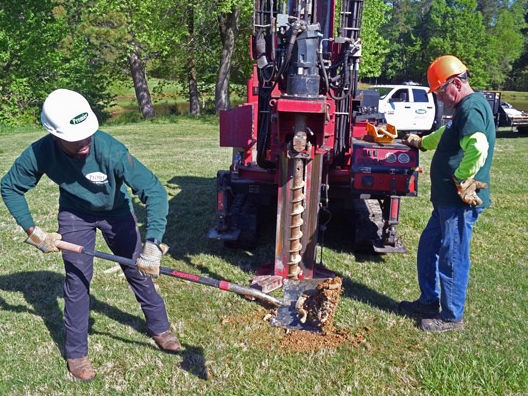Every year, Ron Wallace heads to the University of North Georgia to award a scholarship to a member of the American Institute of Professional Geologists student chapter. But last year he had a unique question for UNG faculty members.
Wallace, who is AIPG president, asked if the Lewis F. Rogers Institute for Environmental and Spatial Analysis wanted a groundwater well on campus.
"All of our eyes lit up," said Dr. Christopher Seminack, assistant professor of geology in IESA. "Then, we said, 'Yes, please!'"
UNG students enrolled in geological classes, specifically, hydrogeology will benefit from the new groundwater well. Seminack explained students will learn firsthand how to record depth of groundwater and monitor the water table as it fluctuates during the seasons. They also will learn to collect groundwater samples from the well.
Seminack said the hands-on experience will aid students and graduates as they apply for jobs in the field.
"Our students will stand out since they will have the experience of monitoring a groundwater well," he said. "These are lessons they usually would not learn until they get into the industry."
Wallace, who worked for the Environmental Protection Division in Georgia, agreed.
"They will get to see and use something that they will not experience in a classroom," he said. "When they apply for a job, they can say I've seen a groundwater well and can describe the soil samples."
Seminack noted not every college or university has access to its own groundwater well.
"From the schools I've attended, this isn't what the average geology department has had," he said.
Wallace said AIPG and Premier have drilled wells for a few Georgia colleges and universities such as Berry College, Georgia Southwestern State University and Columbus State University.
"Groundwater wells usually cost thousands of dollars to install," Seminack said. "Premier Drilling has agreed to install the well for free, for which myself and IESA are extremely grateful."
The partnership between AIPG and Premier Drilling based in Conyers made the request a reality. Company officials used its drilling equipment to dig a 2-inch diameter and 28-feet deep hole in the spring semester in the field near the G.W. Bailey Amphitheater on the Gainesville Campus.
Seminack and Dr. Katayoun Mobasher, professor of geology, watched with smiles as the equipment pounded through the Georgia earth and carefully examined the sediment withdrawn from the ground.
"I wish I had brought my students out to see this," Mobasher said as she studied the samples ranging from the topsoil and the red Georgia clay to the micaschist bedrock.
Seminack said he and the geology faculty will take advantage of the well and its samples.
"This could lead to more research opportunities and expand our academic offerings," he said.









